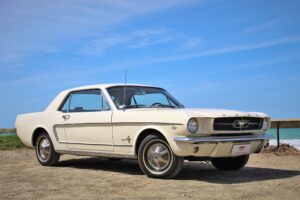
Is the Chevrolet Corvette C2 Stingray the Coolest Corvette Ever?
Share With Friends:
The Corvette is the definitive all-American sports car. Having been in continuous production since 1953, very few people, petrolheads or not, haven’t heard of Chevrolet’s wild child.
While countless variants have come and gone, the second-generation Corvette, is for many people, the Corvette’s finest hour.

The roots of the second-generation car, the C2, can be traced back to the late fifties and two men, Bill Mitchell and Zora Arkus-Duntov.
Engineer Duntov was dead keen to see the next evolution of his beloved sports car take shape. Bill Mitchell was brought on as the lead designer for the project and the two of them got to work.
Various one-off prototypes came and went throughout the late fifties. However, the two cars which really got the ball rolling, were the 1960 Corvette Stingray Special and the 1959 XP-720 Corvette Prototype.

With input from stylist Larry Shinoda, the Stingray Special was like something from outer space. Powered by a 283ci V8, it was rumored to hit 60mph in four seconds.
Mitchell was so impressed with the race ready Special after it’s public debut at the 1961 Chicago Auto Show, that he decided to christen the new production Corvette project, Stingray.
The XP-720 would also be heavy influence on the production Stingray, with its long bonnet and sloping rear. It also featured more storage space and a smoother ride, features which would make the Stingray easier to live with.

The Corvette Stingray was taking shape, its swivel pop up headlights were a master stroke and the striking rear haunches with dual talights were unlike anything before it.
However, it was the Stingrays’ split-rear window which became its biggest feature. It was a first for American production car. Today, Stingray fans today see a split rear window Corvette as motoring mecca.

The C2 Corvette Stingray made its debut in 1963, and the public went wild over it. Duntov saw the Stingray was the car the Corvette was always meant to be, a muscle sports car to take on the European Aristocatic Elite. Duntov even went on record to say “Finally I have a Corvette I can drive over in Europe.”

Available with a small block 5.4-litre 327ci or big block 6.5-litre 396ci or 7.0-litre 427ci V8, a well-tuned Stingray was the weapon of choice for blacktop bandits racing between the lights on late night Detroit streets. The Stingray remained in production as a coupe or convertible for four years before it was replaced by the C3 Stingray in 1968.
This 1967 Stingray Convertible, supplied by Waimak Classic Cars, was one of the last examples produced. Whether you take in the beefed-up rear haunches, pop up headlights, shark gill like side air vents, or the text book long bonnet, a Stingray is a car you can gawp at for hours.

While many gravtitate towards the 427 big-block, the workhorse 327, in this writer’s opinion, provides more than enough grunt for most of us, especially when mated to that classic four on the floor four speed manual box. A rarity in any C2.
Getting in and out is not as awkward as you might think, as the heavy door shuts with a reassuring ‘clunk’ you are reminded this heavy weight champion means business.

Inside, the Stingray’s cabin is one of simplicity. Early sixties American car design still carried over plenty of cues from the fins and Sci Fi obsessed fifties, and the Stingray follows this trend.
The wood rim wheel and simple white on black instruments stare at you like binoculars. Plus, the oversized analogue clock takes centre stage. Your arms outstretch and grab wheel with ease and there is a tonne of room to slob out.

Hold the brake pedal, turn the key and that delicious V8 triumphantly fires. At idle you can almost hear every single cylinder firing. Ahh the audible bliss of a simple small block. The optional side exhausts make all the difference, as every blip of the throttle is even louder.
Once on the move, you quickly remember you are driving a fifty-year-old American car, and all which that implies. Steering is very vague, even when changing lanes.

Several full turns of the wheel are required when leaving a T-Junction. Woe to those who attempt a three-point turn in a hurry too, as the throttle has plenty of travel and the clutch requires a decent boot.
Also, it pays to apply the same philosophy when braking. A firm foot and gritty determination are key to getting the Stingray to pull up in a hurry.
Feed in the power and that muscular bonnet, which seems to stretch to the horizon, rises with ease. In the bends it tracks well despite the complete lack of steering feel.

However, the Corvette comes into its own when out for a cruise. You can rumble around your local suburban stomping ground, or at 100km/h along straight North Canterbury roads. The Stingray makes you giggle as it turns heads and devours the miles.
Is the C2 Chevrolet Corvette Stingray the coolest Corvette ever made? Probably.
By Ben Selby





